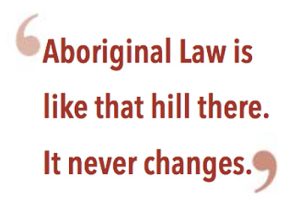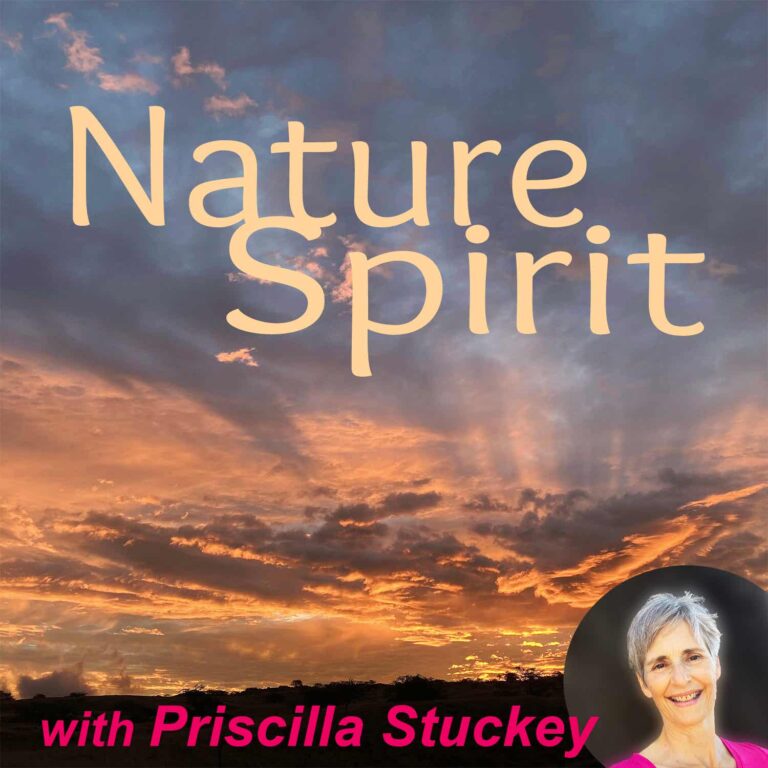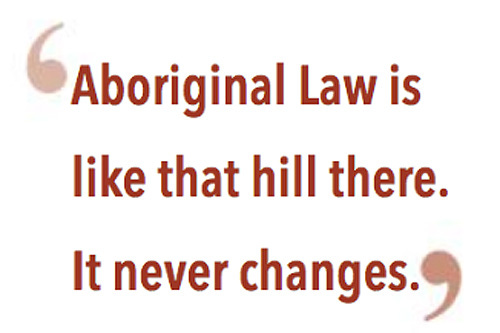Transcript
This week, with our attention on the Supreme Court, I was thinking a lot about one sentence on law that was spoken many years ago by an Indigenous man of Australia. Doug Campbell was sitting one day with the anthropologist Deborah Bird Rose, looking at a large hill across the way.
“You see that hill over there?” he asked Deborah. “Aboriginal law is like that hill there. It never changes.” Doug said that white people’s law “goes this way, that way, all the time changing.” But Aboriginal law? It’s “hard,” he said, “like that hill.”
And then the sentence that has stuck with me since the day I read it: “The Law is in the ground.”

So what did Doug Campbell mean? How can the law be in the ground?
To understand it, let’s look for a moment at Western law, which starts with the idea of property. How to protect the rights of property owners was the founding purpose of Western law, going back even before the Roman Empire. British historian Peter Heather explains that Roman laws existed to protect property, with the harshest punishments reserved for property violations. For example, stealing usually got the death sentence.
So when Roman law got handed down through Europe and England to the Americas, this core purpose of protecting ownership got handed down along with it. Which is why today, as so many people are noticing during the Black Lives Matter movement, the law often seems more loyal to property than human life.
It’s also why, after slavery in this country was outlawed, President Lincoln signed a bill in 1862 to compensate former slave owners for each person they had freed. That’s right—this country has already paid reparations, but not to formerly enslaved people for the loss of their freedom and their labor. No, compensation was paid to white people for their loss of property.
When the founding purpose of law is to protect property, a few implications follow. One is that Western law starts with the individual, not the collective. Law does not in the first place support good relationships or healthy communities or the health of the Earth. Its central focus will be individuals—and especially what those individuals own.
So the good life comes to be framed in terms of owning stuff. In Western societies, people automatically look up to those who own a lot of stuff, just because of their supposed skill in accumulating it. No surprise, then, that Western societies also struggle with greed. We are cultures of possession.
A system of law founded on the idea of property does not rest on anything lasting, as Doug Campbell so clearly saw. Over time, values shift as different commodities move in and out of fashion—whether tulip bulbs or gold or Instagram followers. And laws will shift with the political winds so that norms and ethics may change according to the group in power, which is often the group with more stuff.
Law that supports ownership also fails to build good social relations, because it drives a wedge between haves and have-nots. It solidifies a system of class, because the weight of the law will always rest firmly behind those who have.
And such a system of law creates instability—both economic and social—because wherever there is inequality, as social scientists have shown, people are less happy and less healthy. And this goes for the affluent people as well. Inequality creates stress and uncertainty; it damages quality of life, and everybody’s health suffers, including the health of those at the top.
So what does a system of law look like when it is rooted in the ground?
Among Doug Campbell’s people, the Aboriginal peoples of Australia, it means that all ideas about how to live a good life begin with one question: “What’s good for the land?” Because if the land is healthy, the people will be healthy and happy. It starts with caring for land. It starts with loving the Earth.
Different kinds of land may need different kinds of care, and for Aboriginal peoples, it meant, for one thing, tending the land with fire. Over thousands of years they performed cultural burning, or “cool burning.” They would set small fires in a patchwork pattern arranged over years. These fires enhanced life. They prevented large brushfires, and they promoted the thriving of many kinds of plants and animals. Indigenous tribes in North America cared for the land in similar ways for thousands of years.
What would it look like in Western societies to start with the question “What’s good for the land?” The best answer comes when I think back to my own experience thirty years ago, when I became a long-hauler after a bout of influenza. During Christmas week one year I caught a bad flu, and my fever raged up past 104 degrees.
For months afterward, I just didn’t get better. Two years after that flu, I was still profoundly fatigued. If I left the house, I walked slow and stiff as an old person, and I sat down on whatever bench I could find to rest. I was a doctoral student, but I had to put my program on hold because I had severe brain fog for weeks at a time, like so many people these days who are struggling with the aftereffects of COVID-19.
It was a health crisis. And eventually I discovered there was only one way to get well—one way I had any chance of getting well—and that was to rearrange my priorities and put my health absolutely first. To do only the things that helped me feel better, and to stop doing the things that made me feel worse. This would not guarantee recovery, but at least it would prop open the door.
So I followed a law of the body. I rested. For some years I took a nap every day. I was already following my passions in life, but I pared the rest of my life down even more. I ended relationships that were not joyful, and that included my long-term marriage. I tried to live within my body’s limits, never overextending. And all of this put me in precarious territory, because it meant not earning a living and being very vulnerable.
Plus now I had turned into a social outlier, because very few people around me were living by a law of the body. Other people could get away with cutting their nights of sleep short or putting off following their passions in order to earn money first. Sometimes in a conversation I would catch people narrowing their eyes at me and staring hard, trying to decide if I was sane. One or two accused me of being selfish. It was a lonely road, because the law of the body violated most of the everyday rules.
I’m happy to say, though, that it did work wonders. I spent years regaining all my strength, but caring for my body in this simple and humble way did build a foundation for health. But it took humility—listening for what the body needed and following those cues with unswerving devotion. And this humility was an act of love—loving my body in sickness and in health. Loving my body’s limits—or at least making some peace with them.
And for me it was a profoundly spiritual experience. Because rearranging one’s values means a rearranging of the heart—a spiritual change. And that spiritual change eventually bore fruit. Life filled with more joy than I’d dreamed possible. And more love.
The Earth is in a health crisis now. A severe one. And recovering will mean transforming our values.
We have to put the health of the Earth absolutely first.
It will take rearranging priorities in much the same way my own got rearranged all those years ago. It will take promoting things that enhance life and stopping things that diminish it. It will mean voting for equality and joy—in our relations with each other and with the other animals and plants here on Earth—because equality enhances health, and joy is the fuel of life.
It will mean listening with humility to what the animals and plants and trees and insects need to thrive. It will mean putting their needs first, for they were here first; they prepared the Earth to be friendly to human evolution. Our lives depend on their lives, our health on their health. We can’t live without them.
It will mean loving the Earth, the body of us all. And this will mean changing the law. Transforming the law to value ownership less, and health and life more.
I’m happy to say that many people around the world are already working on this. One exciting development is rights-of-nature law. Already people in at least a dozen countries have passed such laws.
Indigenous groups often lead the way. In New Zealand, the Maori people have won legal rights of personhood for the Whanganui River. The Maori say, “The Great River flows from the mountains to the sea. I am the River, the River is me.”
Kelsey Leonard, a legal scholar of the Shinnecock Nation, says, “I was taught that water is alive. It can hear; it holds memories.” So to deal with today’s water crises, she says, we need to protect water “in the way that you would protect your grandmother, your mother, your sister, your aunties.”
The rights-of-nature movement is growing fast across the US; already more than three dozen local communities have passed ordinances to protect soils or rivers or aquifers. In Great Britain and Europe, many people are working to ban “ecocide,” or the destroying of ecosystems. At the UN they are working to make ecocide the fifth crime against peace.
These laws upend the age-old emphasis in Western history on the rights of property owners. They shift the emphasis to the rights of the land to be healthy. They give nature a voice in court. They move the system of law toward the ground itself.
We cannot live without breathable air, without clean water and soil, without the singing of birds and the vibrant lives of forests. If the animals die, we die too. It is that simple. So coming back to health means loving our body, the Earth. And putting that love into law.
Now that’s the kind of law that can hold us and sustain us. A law that rests in the ground.
For digging deeper
Douglas Campbell’s thoughts on the difference between Aboriginal law and white people’s law came from Dingo Makes Us Human: Life and Land in an Australian Aboriginal Context, by Deborah Bird Rose, who worked as an anthropologist with and advocate for Aboriginal groups in Australia. In 2016 the Australian government returned more than 50,000 hectares of land in the Northern Territory to the Yarralin people, and coverage of the handover event plus a photo of Douglas Campbell and reflections by Debbie Rose are found in the Land Rights News, issue 3 (July 2016) at the Northern Land Council website.
Historian Peter Heather, of King’s College London, delves into property rights and Roman law in his book The Fall of the Roman Empire: A New History (London: Oxford Univ. Press, 2006), especially 138–40.
On reparations to former owners of enslaved people, see Tera W. Hunter’s 2019 article in the New York Times, “When Slaveowners Got Reparations.”
To dig deeper into how economic inequality negatively affects people’s health, a good starting point is the “Inequality and Health” page of Inequality.org.
On the “cool burning” practiced by Aboriginal people of Australia, see the website of the nonprofit Watarrka Foundation: “Aboriginal Fire Management: What Is Cool Burning?”
On cultural burning in North America, KCET in Los Angeles produced a series called “Tending the Wild,” including an episode on cultural burning. They interviewed my friend Jared Dahl Aldern, who talks about cultural burning as a process where people give the “gift of fire to the land, and then the land gives back in the form of fruits and plants.” Jared also wrote an “Introduction to Native Cultural Burning” for the series.
For an introduction to rights-of-nature laws, see Alex May’s recent article in The Ecologist.
Kelsey Leonard, a Shinnecock legal scholar, talked about rights of nature on the TED Radio Hour in August.
For some historical background on rights-of-nature law, see this 2018 article by Mari Margill of the Community Environmental Legal Defense Fund. CELDF provides legal services to communities seeking to put the rights of nature into law. Their website includes lots of resources for and updates from rights-of-nature groups around the world.
For Indigenous groups leading in rights of nature: On the Maori relationship to the Whanganui River in New Zealand, this National Geographic article provides background and gorgeous photographs. The White Earth Band of Ojibwe granted rights of personhood to wild rice, manoomin, last year to protect their rice fields. The Ho-Chunk Nation of Wisconsin placed the rights of nature in their constitution in 2018. Peoples of the Pacific Islands are leading a feasibility study to recognize the Pacific Ocean as a legal entity with its own rights at the level of the United Nations.
For a moving speech on rights of nature, see Markie Miller of Toledo, Ohio, at the United Nations in 2019. Toledo citizens passed a Lake Erie Bill of Rights to protect the lake from pollutants, but under challenges from industry and the state, the courts have not supported it.
The Stop Ecocide website has a wealth of information on ecocide and how people are working to pass laws against it in Great Britain and European countries and at the United Nations.
















